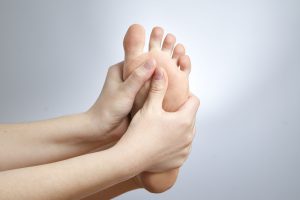Medically Reviewed by Dr. Rachel N. Verville
March 14, 2023

Diabetes is a disease that affects 37.3 million Americans, according to the Centers for Disease Control and Prevention. It is a condition that can have serious effects on various parts of the body. In particular, diabetes can have an impact on your feet.
Learn more about the foot problems that diabetes can cause and what you can do to get help.
What Is Diabetes?
To understand how diabetes can affect your feet, it is important to first know what diabetes is. Diabetes is a metabolic disease that causes problems with blood sugar.
Someone with diabetes does not make enough insulin or is not able to use it effectively. Insulin is a hormone that moves sugar from your blood into your cells so that you can store it or use it for energy. There are two types of diabetes: 1 and 2.
Type 1 diabetes is an autoimmune disease. This is when the immune system attacks the cells in the pancreas — the organ that produces insulin.
Type 2 diabetes happens when the body becomes resistant to insulin, which causes sugar to build up in the blood. It is the more common type of diabetes.
How Diabetes Affects Feet
Diabetes can cause a few types of foot conditions.
Diabetic Neuropathy
Over time, one of the consequences of diabetes is damage to your nerves. Often, this occurs in your legs and feet. This damage makes it impossible for you to feel cold, heat, or discomfort in your feet. If you cannot feel when you receive a cut or blister, you may end up with an infection.
Diabetic neuropathy can also make it so that your feet do not work correctly. The nerve damage impedes their function, and it can lead to the misalignment of your feet as well.
Peripheral Vascular Disease
Diabetes also has a negative impact on blood flow. If you do not have an adequate supply of blood to your feet, any cuts or wounds that you have there may not heal as quickly as they should. This can lead to infections, and eventually, ulcers. If they go untreated, they can end up causing gangrene, or tissue death from a lack of blood.
Symptoms of Diabetic Foot Conditions
Diabetic foot issues can develop slowly and get progressively worse. Some of the most common signs of diabetic foot conditions include:
- Ongoing and persistent discomfort
- Swollen ankle, foot, or leg
- Redness around a sore or wound
- Darkened skin in the affected area
- Numbness
- Tingling
- Loss of hair in the area
If you notice any of these symptoms, the best thing to do is to reach out to a podiatrist for a diagnosis.
Protecting Your Feet
If you have diabetes, it is important to know how to protect your feet from diabetic foot conditions.
One of the things you have to do every day is to check your feet. Look for redness, cuts, blisters, or any other changes to the skin and toenails. Do not forget to check between your toes and on your soles.
You also want to wash your feet every day using warm water and soap. Do not soak your feet, however, since that can cause dryness. You should also apply talcum powder between your toes to soak up moisture. Do not apply lotion between your toes.
If you develop calluses or corns, you should turn to your doctor to help you remove them in a safe manner. Having thickened skin, as can happen when you have a callus, can lead to rubbing and the development of sores. Removing it in the wrong manner can lead to infections, however, so rely on your local podiatrist for help.
When trimming your toenails, cut them straight across.
You want to protect your feet when walking, so make sure to wear socks and shoes that fit correctly and that do not rub your skin uncomfortably. You want to reduce the chance of getting blisters. Make sure the shoes are smooth inside and that there are no seams that can cause damage. Never walk barefoot.
You also want to remember to protect your feet from the cold and the heat. Apply sunscreen if you are walking with exposed skin. In the winter, do not heat your feet with a fireplace or heater.
When you sit, consider putting your feet up to increase blood flow. Throughout the day, wiggle your toes and move your feet around whenever you can. It is important not to wear tight socks. You also want to engage in activities like walking.
To help prevent any issues from arising, always get your feet checked when you visit your doctor.
Treatment of Diabetic Foot Problems
The treatment that will best suit your needs will depend on the severity of your condition. Your doctor may treat the problem with physical therapy, medication, exercise, or even surgery.
If there is a visible diabetic ulcer, treatment can include draining any fluid or pus from the ulcer, cleaning the wound, and removing dead or infected tissue.
There are also special bandages and medications that can absorb extra fluid while protecting the wound. You may get oral or intravenous antibiotics to help clear the infection as well.
If you need to take weight off the foot, you may need to use a wheelchair or crutches temporarily.
Get Help for Diabetic Foot Conditions
If you have diabetes and worry about changes to your feet, the best thing to do is to reach out to a board-certified podiatrist. With the right diagnostic tools and specialists in the field at your side, you can get the assistance you need.









